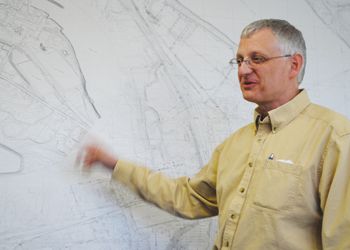Fueling its future | Biobutanol holds promise for the next phase of Old Town Fuel & Fiber
Four years ago, Dan Bird and Dick Arnold stood in an office within a 125-year-old paper mill and looked out the window to an empty plant. The room, once the controller’s office of previous occupant Georgia Pacific, was laid bare: no phones, no computers, no remnants at all of the Atlanta-based paper giant that vacated the Old Town mill to seek higher profits and lower energy costs in warmer climes.
The previous day, Bird and Arnold had attended a press conference with then Gov. John Baldacci, who announced new owners and new investment for the mill that at one time provided 400 jobs in this part of eastern Maine. It was up to the pair — both veterans of a changing paper industry — to bring the mill back to life.
“OK, I guess we’ve got a lot of work to do,” Bird recalls Arnold saying.
And so they have. Today the plant, now Old Town Fuel & Fiber, produces 600 tons of kraft pulp a day to feed a growing global demand. More importantly, the pulp process provides feedstock for a new sustainable fuel derived from wood: biobutanol, a renewable energy substitute for gasoline. The mill, which creates its own power, employs 205, and next month will begin building a biorefinery to make biobutanol for commercial consumption on a site that once housed tissue-making machines. The transformation from a typical paper mill to a value-added, sustainable and diversified manufacturer reflects the business philosophy of the company’s new private equity owner, Lynn Tilton of Patriarch Partners, and holds potential to drive the local economy once again.
“It’s a new chapter for us,” says Bird, who oversees Old Town Fuel & Fiber’s human resources and IT departments. “It was pretty bleak there for a while.”
Market forces
The bleak times started in 2006 when the market for pulp began to change at the same time paper-making operations were moving off shore. At the time, GP was producing about 600 tons a day of pulp, 200 of which fed its own machines to make napkins, toilet paper and paper towels under brand names such as Vanity Fair and Brawny. The other 400 tons were baled and sold as dry pulp. But rising energy costs prompted the company to consider warmer locations where balmy river water didn’t need as much energy or time as the frigid Penobscot’s to reach temperatures hot enough to generate steam to turn turbines and power the plant.
“There was a huge cost differential,” says Bird, between the Maine mill and its southern competition.
GP shuttered the plant, intending to raze it until Baldacci stepped in with a group of investors, pledging to use the mill as a learning laboratory to make cellulosic ethanol, another wood-based biofuel that had been pioneered at the University of Maine. Operating as Red Shield Environmental, the mill restarted the pulping operation in the spring of 2007, then closed in November to reconfigure two digesters to work sequentially, rather than independently — a key component in the pulping process that creates the organic byproduct used in cellulosic ethanol and biobutanol.
But what worked in the lab didn’t quite work in the real world, says Bird. Glitches in the technology created delays. The band of investors, who bought the mill for $1 and lined up millions in financing, needed the revenue from making pulp to sustain it while the kinks were worked out of the cellulosic ethanol process. Facing new competition from overseas and a glut of paper, the domestic pulp market began a slide that didn’t turn around until 2010.
In spring of 2008, Red Shield applied for a $30 million Department of Energy grant to work on cellulosic ethanol — a gasoline additive, not a substitute like butanol — and was approved. But it was too late. In May, the mill shut down for scheduled maintenance, which cost the investors several million dollars, while the pulp market continued to plummet. The following month, nearly everyone was laid off and Red Shield filed for Chapter 11 bankruptcy.
“They just didn’t have the financial wherewithal to ride it out,” says Bird, who worked with Red Shield as its human resources director.
Financial wherewithal isn’t something Lynn Tilton worries much about. Fierce in her business dealings and flashy in her appearance, Tilton is on a crusade to bring back American manufacturing. Her New York private equity firm, Patriarch Partners, controls companies with a combined 120,000 employees and sales of $8 billion, according to the Wall Street Journal. Forbes is so intrigued by her, it’s begun a series to discover if she’s the country’s richest, self-made billionaire.
Her modus operandi is to scoop up distressed properties and turn them around, with a portfolio so extensive, she “basically lives on her jet” visiting her companies, says Bird. And that was part of the hook that attracted Tilton to easten Maine. The R&D under way at the University of Maine had the potential to lead to affordable jet fuel, a prospect Tilton was willing to wager on when she bought the mill at auction for almost $19 million.
But it was the mill’s energy self-reliance that first attracted her to Old Town, she says. “I really believe in putting idled assets and idled people back to work with innovative manufacturing,” she says. “Obviously you can’t do the same thing as before, but I’m not a believer of throwing out old industries and the people who worked in them. I’m drawn to those industries.
”What I liked a lot about Old Town was the work to become a greener facility,” she says. “With the biomass boiler, it’s a net generator of power, not a net user.”
A lesser draw was the potential to make biofuels, but Tilton sees the mill’s investment in that arena as part of a strategy to diversify revenue and maintain consistent cash flow for long-term success. Although the cellulosic ethanol didn’t work for Red Shield, it led to a new process, also developed by the University of Maine’s Forest Bioproducts Research Institute, to make biobutanol. Butanol is an industrial solvent, but when certain enzymes are added to a pulp byproduct and fermented, it becomes biobutanol, a gasoline substitute extracted from renewable organics.
According to Professor Hans Blaschek, head of the Center for Advanced Biorefinery Research at the University of Illinois, biobutanol produces less carbon dioxide, contains more energy density — a measure of how much energy it produces by volume — and fewer greenhouse gas emissions than conventional gasoline, and can be blended with gas or used alone in combustion engines. It also can be transported via existing gas pipelines, an advantage over ethanol.
Blaschek says a company he helped found, Chicago-based TetraVitae Bioscience, is one of a handful gearing up to commercially produce biobutanol.
“There are five or six companies in a dead heat to produce this on a commercial scale,” he says. “The market is huge.”
Bird says Old Town expects to produce biobutanol for commercial use within two years. Although he, too, sees a huge market (some experts put the number at $5 billion), the mill is too small to produce vast quantities of the biofuel. Instead, the greater value will come from refining the extract process in a proprietary technology that will belong to Patriarch Partners.
“We could potentially realize more value in licensing our intellectual property than the biorefinery and the pulp developments,” he says.
Under construction
In a far off corner of the mill where tissue machines once hummed, gleaming new equipment has been erected to bring the production of biobutanol that much closer to reality. Construction on the next phase of that $60 million project starts this summer, says Bird. He credits Tilton with convincing DOE to let her keep its $30 million grant and apply it to biobutanol research rather than cellulosic ethanol, and lining up matching funds.
“People here love her,” says Bird as he pauses to look at an array of photos taken during Tilton’s visit to the mill last July. Clad in black with waist-length blond hair cascading from under a hard hat, she acquiesced to safety standards by replacing her high-heel boots with hot-pink high-tops, helpfully provided by her makeup assistant, who accompanies Tilton everywhere.
A graduate of Yale and Columbia universities, Tilton is decisive about her companies. Bird says as long as Old Town Fuel & Fiber is operating in the black, it has her support. “She says she only flips and strips her men, not her mills,” quips Bird.
And she’s open to additional diversification of revenue for the old mill, including future potential as a data center site, offering data protection and storage separate from the physical locations of computers.
“There’s several companies that would like to take advantage of our behind-the-gate power, especially our power for cooling,” says Bird, noting it’s possible the mill would consider leasing space for a data center and selling its excess power directly to that tenant, rather than the grid. “There are ways this could make sense for us,” he says. “It’s all in keeping with diversifying the operation and the revenue stream.”
Carol Coultas, Mainebiz editor, can be reached at ccoultas@mainebiz.biz.
This story was corrected from the version published June 27.
DOWNLOAD PDFs
Read more
Old Town mill suspends operations 'indefinitely,' lays off 180













Comments